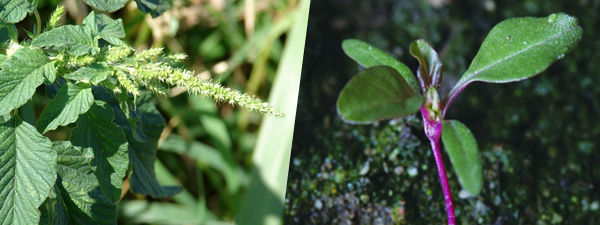Identifying Pigweed and Keeping Resistance at Bay
October 19, 2016

One of the biggest broadleaf weed problems growers across the country face is the pigweed family: spiny, smooth and redroot pigweed; Palmer amaranth; waterhemp; and several other species.
Identifying Pigweed
Most pigweed plants are tall, with simple, alternate leaves that are oval- to diamond-shaped. The plant structure is erect to bushy, with dense, spiky clusters of small, greenish, inconspicuous flowers that lack petals. Flower clusters reach up to 20 centimeters in length at the stem ends and in leaf axils. Spine-tipped bracts make the head appear bristly.
Recent research indicates that some pigweed species respond differently to various herbicides, making proper identification important for good control. Furthermore, some pigweed species may cross-pollinate to produce hybrids, exhibiting characteristics of both parents. Two or more pigweed species often occupy the same field and significant variation can occur between them, making correct identification of each species difficult. It’s impossible to tell at a glance if a pigweed is resistant or non-resistant to one or more herbicides; laboratory testing is required.
Potential Damage and Economic Impact
Pigweed has the potential to inflict complete crop failure if not controlled.
A study recently published in Weed Science demonstrates that glyphosate-resistant Palmer amaranth completely colonized Arkansas cotton fields in just three years, making harvest impossible. In this study, glyphosate herbicide was the only weed management tool used, exposing the need for a zero-tolerance threshold in the management of this herbicide-resistant weed.
In the past, agronomists told farmers to manage pigweed by keeping an eye on their fields through scouting and determining economic thresholds. However, weed control based on an economic threshold – dollars spent versus dollars returned – is no longer adequate (it does not factor in the soil seedbank and the threat of herbicide resistance) and adopting a zero-tolerance policy is necessary.
“A zero-tolerance policy means you don’t even give these weeds a chance to go to seed,” said Jason Manz, Bayer product manager. “You just can’t let these plants go to seed and produce new weeds, because once they get started, they’re difficult to slow down.”
Pigweed Control
Prevent herbicide resistance and/or proliferation of resistant weeds by being certain of weed identification and scouting fields regularly. Get into the field and look for signs of weeds 10 to 12 days after planting. Then scout periodically for four to six weeks, sampling enough areas to get an accurate count of the different weeds present throughout the field.
Treating new infestations immediately and reducing opportunities for their establishment can control pigweed. This weed is relatively susceptible to pre-emergent herbicides and should also be treated with a post-emergence herbicide when still relatively small for the best control. In addition, farmers can plant cover crops, practice crop rotation and, very importantly, diversify their weed management program. When applying herbicides, farmers need to follow their full, labeled rates and use multiple modes of action.
Known Resistance in Pigweed
Some pigweed populations can become resistant to herbicides after repeated years of application. For instance, Palmer amaranth, one of the biggest resistance threats today, has shown documented resistance to ALS inhibitors (Group 2), microtubule inhibitors (Group 3), photosystem II inhibitors (Group 5), EPSP synthase inhibitor such as glyphosate (Group 9), and HPPD inhibitors (Group 27). For further information on resistance confirmed by state, visit the International Survey of Herbicide Resistant Weeds.
Bayer Solutions
Bayer has a broad portfolio to combat tough-to-control and resistant weeds. A well-thought-out herbicide program, using multiple modes of action, should be implemented to sustainably manage weeds. Before applying any herbicide, please read the entire label for the best possible results and to confirm that the product is effective on the weeds you wish to control. Not every product is suitable for every situation, and use of the correct application technique will ensure the best results.
Please visit our corn and soybean pages for information on a portfolio of products from Bayer to help you better manage weeds.